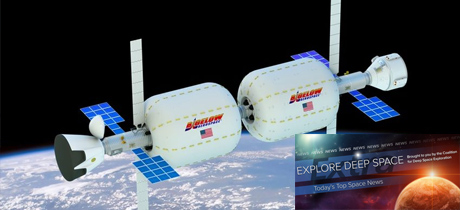In Today’s Deep Space Extra… A new NASA authorization measure that would ease the date for a NASA managed human return to the surface of the Moon cleared its first markup at the subcommittee level on Wednesday and now heads to the House Science, Space and Technology Committee. The U.S. General Accountability Office expresses new concerns about the certification of NASA Commercial Crew Program launch services and the impact delays will have on research aboard the International Space Station (ISS).
Human Space Exploration
House Subcommittee clears NASA Authorization bill, but it’s just the beginning
Spacepolicyonline.com (1/30): A 2020 NASA Authorization bill, introduced late last Friday by the U.S. House Science, Space and Technology Committee’s Space Subcommittee that would ease the urgency of an accelerated 2024 return to the surface of the Moon by NASA with human explorers cleared its first markup session on Wednesday afternoon. Subcommittee leadership suggested NASA could still aim for 2024 rather than the measure’s 2028 goal that also introduces a human mission to Mars orbit by 2033. Changes are anticipated as the measure now moves to the full Science, Space and Technology Committee, perhaps in February.
NASA to have fewer astronauts in space if Boeing, SpaceX don’t start flying soon
Coalition Member in the News – Boeing
Houston Chronicle (1/29): The U.S. General Accountability Office (GAO) in a report issued Wednesday expressed concerns over NASA’s ability to staff the six to seven person International Space Station (ISS) if its Commercial Crew Program partners are unable to complete near term certification of Boeing’s CST-100 Starliner and SpaceX’s Crew Dragon by the spring of this year. The size of the orbiting’s lab crew is expected to drop from six to three in April, including only one NASA astronaut, an outcome sure to lower scientific research and technology development activities. With the dates for crew test flights still uncertain, NASA is pursuing the purchase addition transportation from Russia aboard three person Soyuz capsules, the only means of human transportation to and from the Space Station since the space shuttle fleet was retired in 2011.
Bigelow Aerospace sets sights on free-flying station after passing on ISS commercial module
Coalition Member in the News – Axiom Space
SpaceNews.com (1/29): Robert Bigelow, of Bigelow Aerospace, intends to invest in a commercial space station, though he backed off bidding for an opportunity to dock a habitation module to the International Space Station (ISS) as a next step. Earlier this week, NASA announced that Axiom Space, of Houston, had been selected to pursue that course, as NASA aims to transition its human spaceflight focus from low Earth orbit to deep space. NASA would like to become one of many customers of a commercial space station landlord. Currently, Bigelow has a prototype expandable module in a test posture at the International Space Station (ISS). The evaluations could lead to the use of expandable modules for deep space travel or habitation on planetary surfaces.
Space Science
NSF’s newest solar telescope produces first images
Association of Universities for Research in Astronomy (1/29): The first images from the Daniel K. Inouye Solar Telescope in Hawaii are providing the highest resolution images of the sun’s surface. Those suggest the 4 meter Inouye telescope will enable a new era of solar science and a deeper understanding of the sun’s influence on the Earth.
It ‘lifted the cosmic veil on the universe:’ NASA’s Spitzer Space Telescope to be ‘retired’ on Thursday
Universe Today (1/29): Launched in 2003, NASA’s final Great Observatory, the Spitzer Space Telescope, will end its long mission Thursday. Spitzer opened the distant universe to infrared observations. The James Webb Space Telescope (JWST) is slated to take Spizer’s place in the infrared arena, launching potentially in March 2021. The launch date for the technically complex Webb observatory is under review.
Op-Ed
The U.S. must continue to prioritize research and development, especially through NASA
The Hill (1/27): U.S. Rep. Ted Yoho, of Florida, makes the case for the human exploration of space beyond low Earth orbit and the Moon, though backed by innovation and research forged through investments in research. “If you ask me, there is still quite a bit we can learn from space,” writes Yoho. “Sure we have walked on the Moon, but only robots have walked on Mars. And if we’re going to get to where sometime in the near future a person can walk on Mars- we need to start researching what that looks like today.” NASA, he says, is the right agency to lead the effort.
Other News
Close call: Satellites avoid collision over Pittsburgh
Pittsburgh Post-Gazette (1/29): Earlier predictions of a possible collision between two no longer operational NASA and U.S. Air Force satellites in the skies over Pittsburgh on Wednesday night were apparently narrowly avoided. Trackers of the spacecraft warned a collision could create thousands of new debris in orbit around the Earth, posing a collision threat to active satellite missions.
SpaceX launches fourth batch of Starlink satellites, tweaks satellite design
SpaceNews.com (1/29): For the second time in January, SpaceX succeeded early Wednesday in launching 60 Starlink internet satellites and deploying them in an initial 302 kilometer (189 mile) high altitude for check out. Once checked out, the small satellites would be raised to a 550 (344 miles) kilometer high operational orbit. The higher altitude promises a longer orbital lifetime. The spacecraft reflect an upgrade over those launched on previous missions. The launch marked the third for the recovered Falcon 9 first stage. Half the payload fairing was recovered as well.

